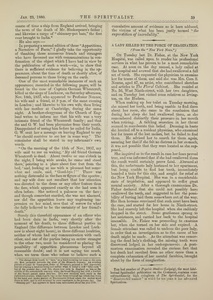< An Apparition Seen by the Supreme Council of India (continued from page 10-244) >
course of time a ship from England arrived, bringing the news of the death of Mr. Shakespeare’s father; and likewise a cargo of “chimney-pot hats,” the first ever brought to India.*
He also says:—
In preparing a second edition of these “Apparitions, a Narrative of Facts” I gladly take the opportunity of thanking those numerous friends and strangers who have favoured me with communications in confirmation of the object which I have had in view by the publication of such a work—viz., to show that there is sufficient evidence for believing in the appearance, about the time of death, or shortly after, of deceased persons to those living on the earth.
One of the most remarkable instances of such an appearance, recorded in the following pages, will be found in the case of Captain German Wheatcroft, killed at the siege of Lucknow, on Saturday afternoon, Nov. 14ith, 1857, who appeared to Professor Nenner, his wife and a friend, at 9 p.m. of the same evening in London; and likewise to his own wife, then living with her mother at Cambridge, during the same night. A brother-clergyman of the Church of England writes to inform me that his wife was a very intimate friend of the Wheatcroft family; and that she and G. W. had been playmates from their youth. Disappointed of seeing him before he sailed for India, G. W. sent her a message on leaving England to say “he should contrive to see her in some way.” The remainder shall be stated in my informant’s own words.
“On the morning of the 15th of Nov., 1857, my wife said to me on waking, ‘My old friend German Wheatcroft is dead. About twelve or one o’clock in the night, I being wide awake, he came and stood there,’ pointing to a place about four feet from the bed, ‘and, looking at me with a pleasant but somewhat sad smile, said, “Good-bye!”’ There was nothing distressful in the face or figure of the spectre; and my wife does not recollect that her attention was directed to the dress or any other feature than the face, which appeared exactly as she had seen it often before. She noticed a paleness on the face; and though somewhat startled, she was not alarmed, nor did the apparition leave any unpleasing impression on her mind, save that of sorrow for what she fully believed to be the certainty of her friend’s death.”
Surely this threefold appearance of an officer who had been slain in India, very shortly after the moment of his death, to three different parties in England (the difference between London and Lucknow is about eight hours), in three different localities, neither of whom had any communication with each other, and one of the parties being an entire stranger to the other two, must be considered as placing the possibility of apparition phenomena beyond all reasonable doubt; and it is not saying too much, when we term those who refuse to believe such a cumulative amount of evidence as is here adduced, the victims of what has been justly termed “the superstition of incredulity.”
* The change from hoods to “hats,” as a head-covering for men in the open air, first occurred towards the close of the fifteenth century. An existing picture of Louis de Gonzagues, Duke of Nivernois, painted in 1587, represents him as wearing a head-covering not unlike what is called a stiff “billy-cock” hat of the present day; and this shape was seen in England as late as the middle of the seventeenth century, when the broad flapping hat with a feather of the Stuart period came into use. This was retained until early in the eighteenth century, when it gave way to the three-cornered hat which was worn by the head and under master of Westminster School when the author went there in 1828; and is still retained by state coachmen in the present day. The “chimney-pot” hat appears to have been introduced about the year 1780.
A Lady Killed by the Force of Imagination
...
The last number of Psychic Studies...
...
Editor's notes
Sources
-
London Spiritualist, No. 387, January 23, 1880, pp. 39


